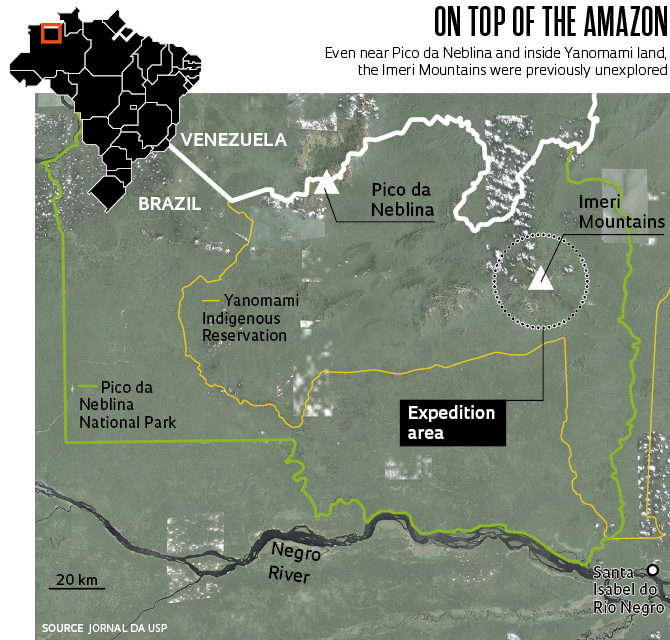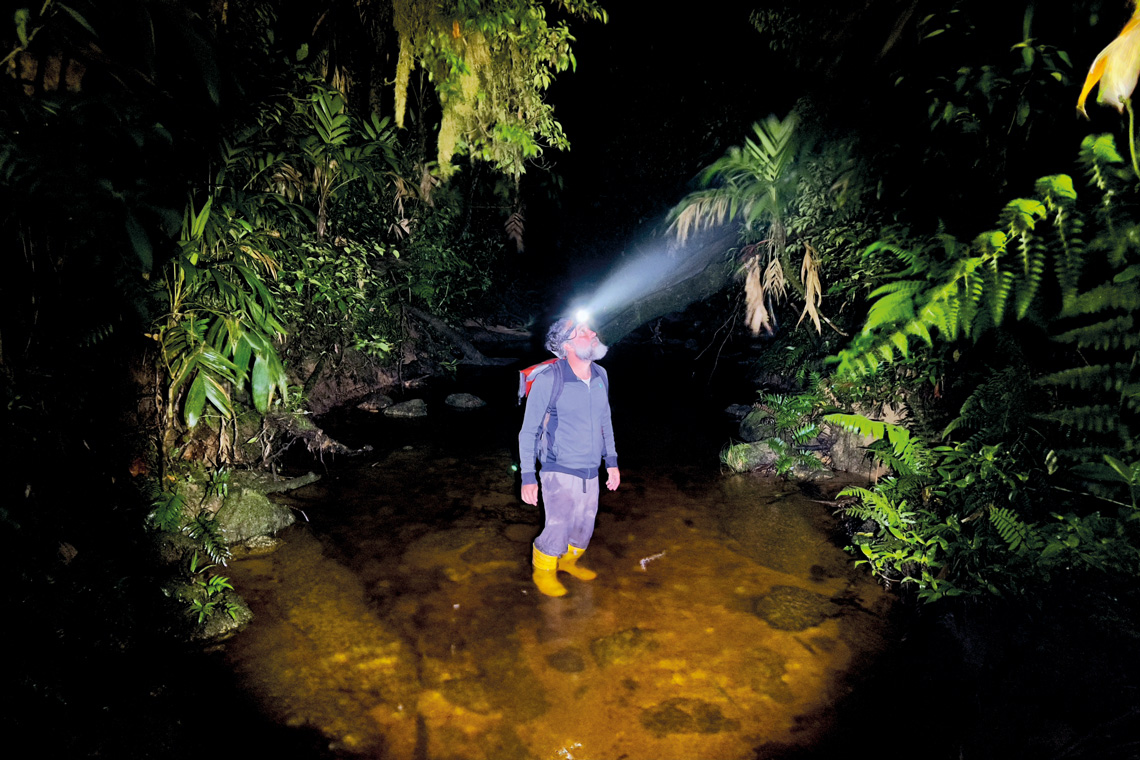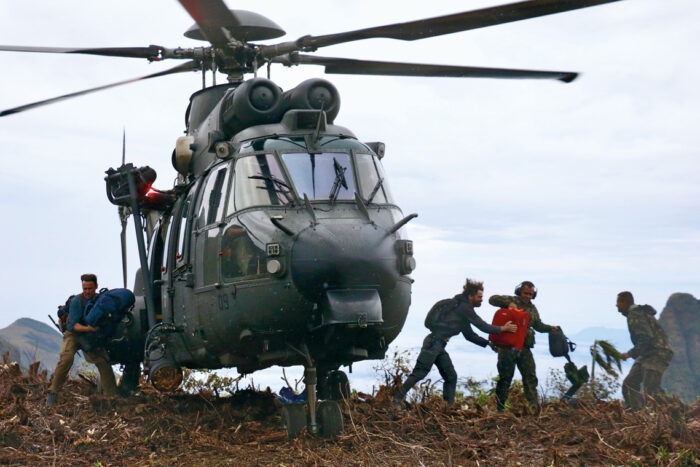It is difficult to reach the Imeri Mountains, which are located in the north of Amazonas near Brazil’s border with Venezuela. At altitudes of up to 2,450 meters (m), the mountainous environment features bromeliad fields, rocky cliffs, and trees surrounded by fog. The area does not seem to have ever been visited by people and is probably home to many unknown animal and plant species. A team of researchers — 12 from Brazil, one from Spain, and one from France — spent 11 days there in November, on a scientific expedition carried out together with the Brazilian Army.
The biologists collected hundreds of specimens, some that appeared to represent species that have never been described, and gathered information that they hope will provide a greater insight into the relationships between animals and plants in this and other high-altitude regions of Brazil.
“In almost 40 years of field research, I have never found such a large proportion of probable new species,” says Miguel Trefaut Rodrigues, a zoologist from the University of São Paulo (USP) and leader of the expedition. In his laboratory a week after returning from the trip, he showed Pesquisa FAPESP dozens of glass jars containing lizards and frogs. Two lizards are similar to specimens of the genus Riomlama collected during a 2017 expedition he led to Pico da Neblina, 90 kilometers (km) to the southeast.

Herton Escobar / USP ImagensRafaela Forzza (white sweatshirt) and Lucia Lohmann (blue shirt), helped by Corporal Marcio Junior da Silva Garcia, descend ropes toward sampling sitesHerton Escobar / USP Imagens
The Imeri Mountains and Pico da Neblina were part of a large plateau formed of sandstone rocks that occupied much of the so-called Guiana Shield before the formation of the Andes. Erosion of these rocks over millions of years helped form the soil in the surrounding lowland forests, leaving many animal and plant species stranded on the peaks of flattened or table-top mountains known as tepuis, such as Neblina, and isolated mountain ranges. Taran Grant, a zoologist from USP, collected a species of tree frog of the genus Myersiohyla from Imeri and saw similarities with species of the genus Hyloscirtus, which live in mountainous environments in the Colombian Andes, more than a thousand kilometers away.
The lizards were captured in traps or by hand during the day, while at night they were usually found asleep between rocks or in trees. The frogs, meanwhile, were all caught at night. Grant and his team followed the nocturnal vocalizations of frogs to find them on stream and riverbanks. “We found four frogs and a caecilia — a type of amphibian — that could be new species,” says Grant.

Herton Escobar / USP ImagensRafaela Forzza and Lúcia Lohmann collect plants and Taran Grant, tadpolesHerton Escobar / USP Imagens
Inhospitable environment
Few species have adapted to the nutrient-poor, rocky soil and average daily temperature variations of 20 degrees Celsius (°C) at the top of the Imeri Mountains. The diversity there is therefore much lower than in the neighboring lowland forests. Many of the species that exist in the region are endemic, meaning they are isolated species that can only be found there.
“We found few species for most of the families of collected plants, indicating that these lineages have not diversified much in the mountains or they gave rise to species that are now already extinct,” says USP botanist Lúcia Lohmann, who specializes in vines of the Bignoniaceae family. “However, these mountains seem to have been the birthplace of many botanical groups.” According to Lohmann, it is possible that various angiosperm families (plants that bear flowers or fruits) first emerged there before later spreading to the Atlantic Forest and lower areas of the Amazon, where they diversified greatly.
 Alexandre Affonso / Revista Pesquisa FAPESP
Alexandre Affonso / Revista Pesquisa FAPESP
One example is Brocchinia hechtioides, a bromeliad that grows in wetland areas of the Imeri Mountains, identified by Rafaela Forzza of the Rio de Janeiro Botanical Garden, one of the expedition’s participants. “It is a carnivorous bromeliad that has only been recorded twice in the country,” she says. “Although we only found one species of the genus Brocchinia, it is abundant in the highlands of these mountains and it is one of the oldest lineages of Bromeliaceae, a particularly diverse family of plants in the Atlantic Forest.” The 1,200 samples of 220 plant species collected by the team will be distributed among specialists from Brazil and other countries, who will collaborate to identify the material.
“Because small mammals arrived in South America later than other animals and plants on the geologic time scale, they were probably the last groups of animals to remain isolated in the mountain range and specialize there,” says the zoologist Alexandre Reis Percequillo of USP’s Luiz de Queiroz College of Agriculture (ESALQ). Ana Paula Carmignotto, a biologist from the Federal University of São Carlos (UFSCar), collected a marsupial, three rodent species, and three bat species, which preliminary assessments suggest are similar to species found in Pico da Neblina.
In addition to collecting plants and animals, some of the researchers on the expedition carried out experiments. Agustin Guerrero, a zoologist from USP, placed reptiles and amphibians in a box connected to a heat source and slowly increased the temperature until the animals left the box. The results indicated which locations would be too hot for these species to survive.

Herton Escobar / USP ImagensJosé Mario Ghellere looks for reptiles and amphibians during the nightHerton Escobar / USP Imagens
“Imeri reptiles and amphibians have a low tolerance for high temperatures. They all left the box at less than 34 °C,” noted Guerrero. “They would be in danger if their habitats reached that temperature.”
Before the expedition, the scientists practiced boarding and disembarking the helicopter by rope, in case an emergency should occur — which fortunately did not happen. A group of 22 military personnel accompanied the team, transporting the biologists and their equipment on eight helicopter trips.
The expedition landed in an area of very wet ground at an altitude of 1,900 m. The helicopter that had carried the team had to land lightly on the ground to avoid sinking into the mud. The military team had tried in vain to find a way of accessing the area by land, but not even the Yanomami indigenous people — who are originally from the region — knew how to reach the top of the mountains, due to the steep terrain.
On the first day at the camp, the group cleared three trails, each about 1 km long and some so steep that they could only be traversed with the aid of a rope. Three scientists injured their ribs, eyes, and shoulders and had to be treated by Army medical staff. Water from the incessant rainfall and mud washed into their tents. But their lives were a little easier when the sun came out.



